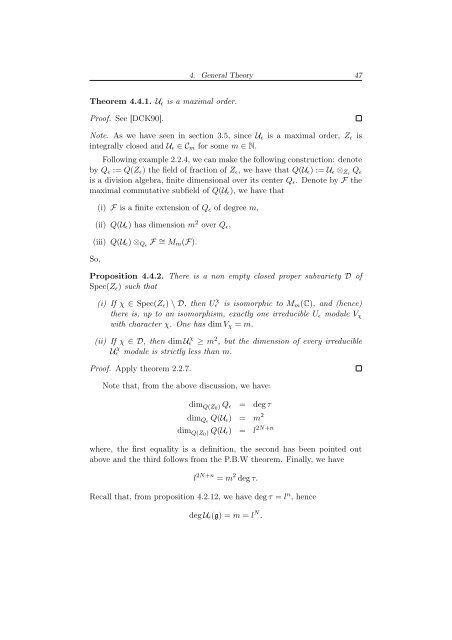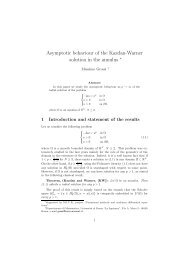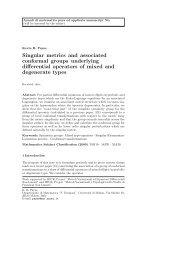Degree of Parabolic Quantum Groups - Dipartimento di Matematica ...
Degree of Parabolic Quantum Groups - Dipartimento di Matematica ...
Degree of Parabolic Quantum Groups - Dipartimento di Matematica ...
You also want an ePaper? Increase the reach of your titles
YUMPU automatically turns print PDFs into web optimized ePapers that Google loves.
Theorem 4.4.1. Uǫ is a maximal order.<br />
Pro<strong>of</strong>. See [DCK90].<br />
4. General Theory 47<br />
Note. As we have seen in section 3.5, since Uǫ is a maximal order, Zǫ is<br />
integrally closed and Uǫ ∈ Cm for some m ∈ N.<br />
Following example 2.2.4, we can make the following construction: denote<br />
by Qǫ := Q(Zǫ) the field <strong>of</strong> fraction <strong>of</strong> Zǫ, we have that Q(Uǫ) := Uǫ ⊗Zǫ Qǫ<br />
is a <strong>di</strong>vision algebra, finite <strong>di</strong>mensional over its center Qǫ. Denote by F the<br />
maximal commutative subfield <strong>of</strong> Q(Uǫ), we have that<br />
(i) F is a finite extension <strong>of</strong> Qǫ <strong>of</strong> degree m,<br />
(ii) Q(Uǫ) has <strong>di</strong>mension m 2 over Qǫ,<br />
(iii) Q(Uǫ) ⊗Qǫ F ∼ = Mm(F).<br />
So,<br />
Proposition 4.4.2. There is a non empty closed proper subvariety D <strong>of</strong><br />
Spec(Zǫ) such that<br />
(i) If χ ∈ Spec(Zǫ) \ D, then U χ ǫ is isomorphic to Mm(C), and (hence)<br />
there is, up to an isomorphism, exactly one irreducible Uǫ module Vχ<br />
with character χ. One has <strong>di</strong>mVχ = m.<br />
(ii) If χ ∈ D, then <strong>di</strong>m U χ ǫ ≥ m 2 , but the <strong>di</strong>mension <strong>of</strong> every irreducible<br />
U χ ǫ module is strictly less than m.<br />
Pro<strong>of</strong>. Apply theorem 2.2.7.<br />
Note that, from the above <strong>di</strong>scussion, we have:<br />
<strong>di</strong>m Q(Z0) Qǫ = deg τ<br />
<strong>di</strong>mQǫ Q(Uǫ) = m 2<br />
<strong>di</strong>m Q(Z0) Q(Uǫ) = l 2N+n<br />
where, the first equality is a definition, the second has been pointed out<br />
above and the third follows from the P.B.W theorem. Finally, we have<br />
l 2N+n = m 2 deg τ.<br />
Recall that, from proposition 4.2.12, we have deg τ = l n , hence<br />
deg Uǫ(g) = m = l N .








